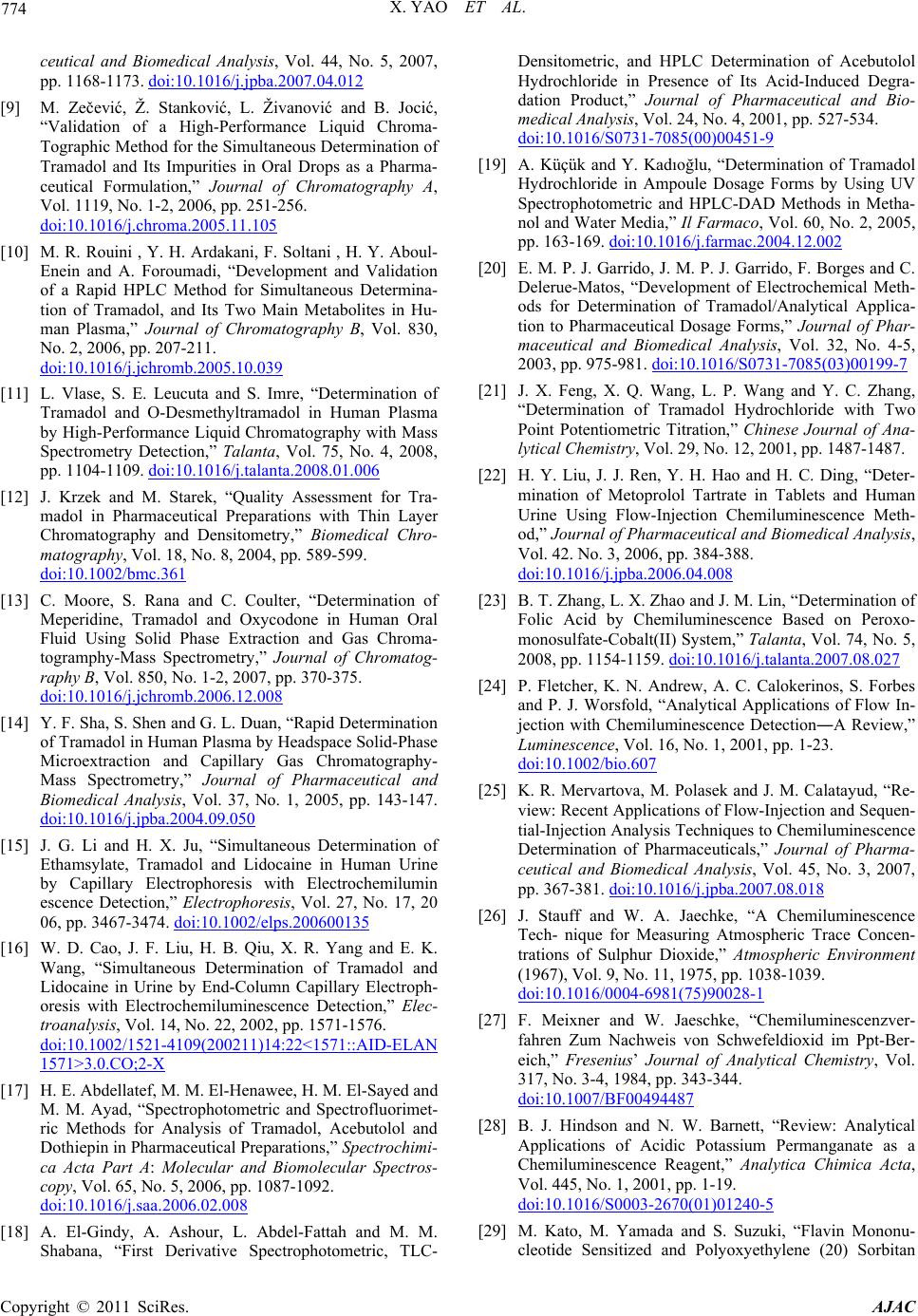
X. YAO ET AL.
774
ceutical and Biomedical Analysis, Vol. 44, No. 5, 2007,
pp. 1168-1173. doi:10.1016/j.jpba.2007.04.012
[9] M. Zečević, Ž. Stanković, L. Živanović and B. Jocić,
“Validation of a High-Performance Liquid Chroma-
Tographic Method for the Simultaneous Determination of
Tramadol and Its Impurities in Oral Drops as a Pharma-
ceutical Formulation,” Journal of Chromatography A,
Vol. 1119, No. 1-2, 2006, pp. 251-256.
doi:10.1016/j.chroma.2005.11.105
[10] M. R. Rouini , Y. H. Ardakani, F. Soltani , H. Y. Aboul-
Enein and A. Foroumadi, “Development and Validation
of a Rapid HPLC Method for Simultaneous Determina-
tion of Tramadol, and Its Two Main Metabolites in Hu-
man Plasma,” Journal of Chromatography B, Vol. 830,
No. 2, 2006, pp. 207-211.
doi:10.1016/j.jchromb.2005.10.039
[11] L. Vlase, S. E. Leucuta and S. Imre, “Determination of
Tramadol and O-Desmethyltramadol in Human Plasma
by High-Performance Liquid Chromatography with Mass
Spectrometry Detection,” Talanta, Vol. 75, No. 4, 2008,
pp. 1104-1109. doi:10.1016/j.talanta.2008.01.006
[12] J. Krzek and M. Starek, “Quality Assessment for Tra-
madol in Pharmaceutical Preparations with Thin Layer
Chromatography and Densitometry,” Biomedical Chro-
matography, Vol. 18, No. 8, 2004, pp. 589-599.
doi:10.1002/bmc.361
[13] C. Moore, S. Rana and C. Coulter, “Determination of
Meperidine, Tramadol and Oxycodone in Human Oral
Fluid Using Solid Phase Extraction and Gas Chroma-
togramphy-Mass Spectrometry,” Journal of Chromatog-
raphy B, Vol. 850, No. 1-2, 2007, pp. 370-375.
doi:10.1016/j.jchromb.2006.12.008
[14] Y. F. Sha, S. Shen and G. L. Duan, “Rapid Determination
of Tramadol in Human Plasma by Headspace Solid-Phase
Microextraction and Capillary Gas Chromatography-
Mass Spectrometry,” Journal of Pharmaceutical and
Biomedical Analysis, Vol. 37, No. 1, 2005, pp. 143-147.
doi:10.1016/j.jpba.2004.09.050
[15] J. G. Li and H. X. Ju, “Simultaneous Determination of
Ethamsylate, Tramadol and Lidocaine in Human Urine
by Capillary Electrophoresis with Electrochemilumin
escence Detection,” Electrophoresis, Vol. 27, No. 17, 20
06, pp. 3467-3474. doi:10.1002/elps.200600135
[16] W. D. Cao, J. F. Liu, H. B. Qiu, X. R. Yang and E. K.
Wang, “Simultaneous Determination of Tramadol and
Lidocaine in Urine by End-Column Capillary Electroph-
oresis with Electrochemiluminescence Detection,” Elec-
troanalysis, Vol. 14, No. 22, 2002, pp. 1571-1576.
doi:10.1002/1521-4109(200211)14:22<1571::AID-ELAN
1571>3.0.CO;2-X
[17] H. E. Abdellatef, M. M. El-Henawee, H. M. El-Sayed and
M. M. Ayad, “Spectrophotometric and Spectrofluorimet-
ric Methods for Analysis of Tramadol, Acebutolol and
Dothiepin in Pharmaceutical Preparations,” Spectrochimi-
ca Acta Part A: Molecular and Biomolecular Spectros-
copy, Vol. 65, No. 5, 2006, pp. 1087-1092.
doi:10.1016/j.saa.2006.02.008
[18] A. El-Gindy, A. Ashour, L. Abdel-Fattah and M. M.
Shabana, “First Derivative Spectrophotometric, TLC-
Densitometric, and HPLC Determination of Acebutolol
Hydrochloride in Presence of Its Acid-Induced Degra-
dation Product,” Journal of Pharmaceutical and Bio-
medical Analysis, Vol. 24, No. 4, 2001, pp. 527-534.
doi:10.1016/S0731-7085(00)00451-9
[19] A. Küçük and Y. Kadıoğlu, “Determination of Tramadol
Hydrochloride in Ampoule Dosage Forms by Using UV
Spectrophotometric and HPLC-DAD Methods in Metha-
nol and Water Media,” Il Farmaco, Vol. 60, No. 2, 2005,
pp. 163-169. doi:10.1016/j.farmac.2004.12.002
[20] E. M. P. J. Garrido, J. M. P. J. Garrido, F. Borges and C.
Delerue-Matos, “Development of Electrochemical Meth-
ods for Determination of Tramadol/Analytical Applica-
tion to Pharmaceutical Dosage Forms,” Journal of Phar-
maceutical and Biomedical Analysis, Vol. 32, No. 4-5,
2003, pp. 975-981. doi:10.1016/S0731-7085(03)00199-7
[21] J. X. Feng, X. Q. Wang, L. P. Wang and Y. C. Zhang,
“Determination of Tramadol Hydrochloride with Two
Point Potentiometric Titration,” Chinese Journal of Ana-
lytical Chemistry, Vol. 29, No. 12, 2001, pp. 1487-1487.
[22] H. Y. Liu, J. J. Ren, Y. H. Hao and H. C. Ding, “Deter-
mination of Metoprolol Tartrate in Tablets and Human
Urine Using Flow-Injection Chemiluminescence Meth-
od,” Journal of Pharmaceutical and Biomedical Analysis,
Vol. 42. No. 3, 2006, pp. 384-388.
doi:10.1016/j.jpba.2006.04.008
[23] B. T. Zhang, L. X. Zhao and J. M. Lin, “Determination of
Folic Acid by Chemiluminescence Based on Peroxo-
monosulfate-Cobalt(II) System,” Talanta, Vol. 74, No. 5,
2008, pp. 1154-1159. doi:10.1016/j.talanta.2007.08.027
[24] P. Fletcher, K. N. Andrew, A. C. Calokerinos, S. Forbes
and P. J. Worsfold, “Analytical Applications of Flow In-
jection with Chemiluminescence Detection―A Review,”
Luminescence, Vol. 16, No. 1, 2001, pp. 1-23.
doi:10.1002/bio.607
[25] K. R. Mervartova, M. Polasek and J. M. Calatayud, “Re-
view: Recent Applications of Flow-Injection and Sequen-
tial-Injection Analysis Techniques to Chemiluminescence
Determination of Pharmaceuticals,” Journal of Pharma-
ceutical and Biomedical Analysis, Vol. 45, No. 3, 2007,
pp. 367-381. doi:10.1016/j.jpba.2007.08.018
[26] J. Stauff and W. A. Jaechke, “A Chemiluminescence
Tech- nique for Measuring Atmospheric Trace Concen-
trations of Sulphur Dioxide,” Atmospheric Environment
(1967), Vol. 9, No. 11, 1975, pp. 1038-1039.
doi:10.1016/0004-6981(75)90028-1
[27] F. Meixner and W. Jaeschke, “Chemiluminescenzver-
fahren Zum Nachweis von Schwefeldioxid im Ppt-Ber-
eich,” Fresenius’ Journal of Analytical Chemistry, Vol.
317, No. 3-4, 1984, pp. 343-344.
doi:10.1007/BF00494487
[28] B. J. Hindson and N. W. Barnett, “Review: Analytical
Applications of Acidic Potassium Permanganate as a
Chemiluminescence Reagent,” Analytica Chimica Acta,
Vol. 445, No. 1, 2001, pp. 1-19.
doi:10.1016/S0003-2670(01)01240-5
[29] M. Kato, M. Yamada and S. Suzuki, “Flavin Mononu-
cleotide Sensitized and Polyoxyethylene (20) Sorbitan
Copyright © 2011 SciRes. AJAC